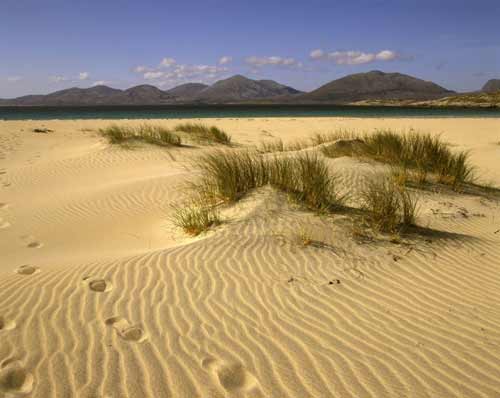To find a great beach, head for the Hebrides
Say island-hopping, think Greece. But there are options closer to home. Louise Jury heads out to sea off Scotland's west coast

Your support helps us to tell the story
From reproductive rights to climate change to Big Tech, The Independent is on the ground when the story is developing. Whether it's investigating the financials of Elon Musk's pro-Trump PAC or producing our latest documentary, 'The A Word', which shines a light on the American women fighting for reproductive rights, we know how important it is to parse out the facts from the messaging.
At such a critical moment in US history, we need reporters on the ground. Your donation allows us to keep sending journalists to speak to both sides of the story.
The Independent is trusted by Americans across the entire political spectrum. And unlike many other quality news outlets, we choose not to lock Americans out of our reporting and analysis with paywalls. We believe quality journalism should be available to everyone, paid for by those who can afford it.
Your support makes all the difference.When people go island-hopping, they usually try Greece. Few try the Outer Hebrides. Yet, when the sun comes out, the turquoise halo surrounding Harris and Lewis stretching down through the Uists to Barra renders them as jewel-like as any cluster of islands in the Med. Admittedly, even in high summer, the sun is a wayward presence. But there are compensating pleasures for a traveller willing to stop and look.
Getting there, however, is not a straightforward business. Those with a strong stomach can fly into Barra on a tiny plane, which lands on a stretch of white-gold beach. We opted to hire a car from behind the railway station in Inverness, and catch the Caledonian MacBrayne ferry from Ullapool to begin our adventure from Stornoway, a town previously known to us only as a faraway reference point on the weather forecast.
Stornoway has its charms. There are pubs whose interiors appear to have been untouched for the best part of a century, a traditional museum worth an hour or two's pottering, and the stylish An Lanntair Arts Centre, where the town's trendies enjoy a drink and exhibition. The Lewis Loom Centre displays examples of the island's traditional Harris tweed in an eccentric clutter.
But the essence of the Outer Hebrides lies elsewhere, in the geometric cuts of the peat fields of Harris, or the eagles soaring over Benbecula and South Uist and the tiny baby hedgehog which we found snuffling down a country road, utterly bemused to discover a vehicle in his path.
The number of major tourist attractions in the Outer Hebrides is small. Yet the biggest site, the 4,000-year-old standing stones at Callanish on the isle of Lewis, is as astonishing as Stonehenge. Thirteen primary stones of local gneiss rock form a circle with a long approach avenue of stones to the north and shorter rows to the other compass points.
The raison d'être of the stones is not clear, though the alignments suggest they may have had astronomical significance as a form of calendar. Once every 18.6 years, the moon appears to bounce along the top of the neighbouring mountains. The other intriguing attraction on Harris and Lewis – which is one island despite two names – are the traditional blackhouses. They were made of stone with a thatch or turf roof, and the fire in the middle of the main room had no chimney, only a hole above, making the interiors dark and smoky. Slightly modernised versions were in use until the 1970s. There is now a museum and some of the abandoned homes have been turned into holiday cottages.
But the area's real beauty lies in the miles of beaches around Luskentyre, where golden sand is rippled by the waves against a backdrop of high hills. There can scarcely be a more beautiful spot anywhere – even if the wind is whipping.
Another ferry hop took us to North Uist, Benbecula, South Uist and the tiny Eriskay, whose isolated status was eased by the building of connecting causeways. We were still often the only people strolling a beach, though we did see a handful of more adventurous visitors sea-kayaking.
But there was also a chance for luxury. Three brothers, Iain, Roddy and Norman MacLeod, opened a new hotel, the Tigh Dearg at Lochmaddy, two years ago, complete with designer rooms and elegant touches such as handmade soaps, a sauna and as much food sourced locally as possible.
Travelling further, past the "otters crossing" signs on the causeways, it was the small island of Eriskay that became our favourite spot. Famous as the setting of the classic film comedy Whisky Galore!, it was where we were adopted by an enthusiastic collie who guarded our tent with a fierce loyalty.
A brisk but barely difficult climb to the highest point on the island gave a bird's eye view back across the causeway and on to our next and final destination, Barra. There, we enjoyed probably the best meal of the trip – crab claws and chips at the friendly Heathbank Hotel – before taking the long journey back to the mainland at Oban.
Standing on the ferry, we watched the islands retreat into sea and sky, leaving just the memories of imposing standing stones and an irrepressible collie.
COMPACT FACTS
How to get there
A six-night stay in the Outer Hebrides with McKinlay Kidd (08707 60 60 27; www.seescotlanddifferently.co.uk) costs from £545 per person, based on two sharing, between May and September. The price includes ferry crossings from Oban-Barra, Barra-Eriskay, North Uist-Harris, and Stornoway-Ullapool (or Harris-Skye) for a car and two adult passengers, b&b and a personalised route from your specified starting point with suggestions on places to see, depending on your interests.
Join our commenting forum
Join thought-provoking conversations, follow other Independent readers and see their replies
Comments